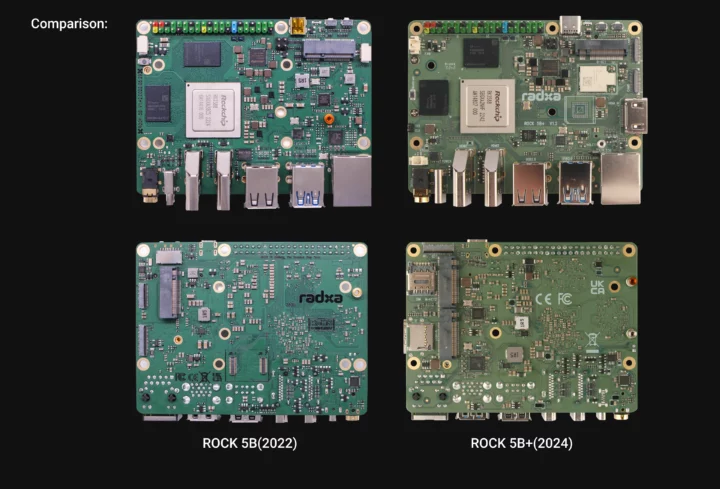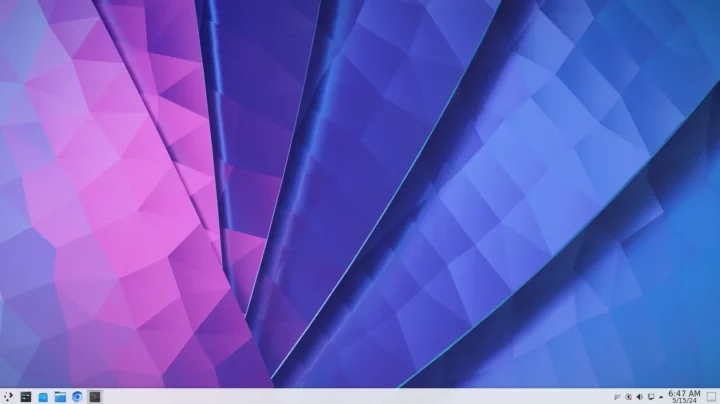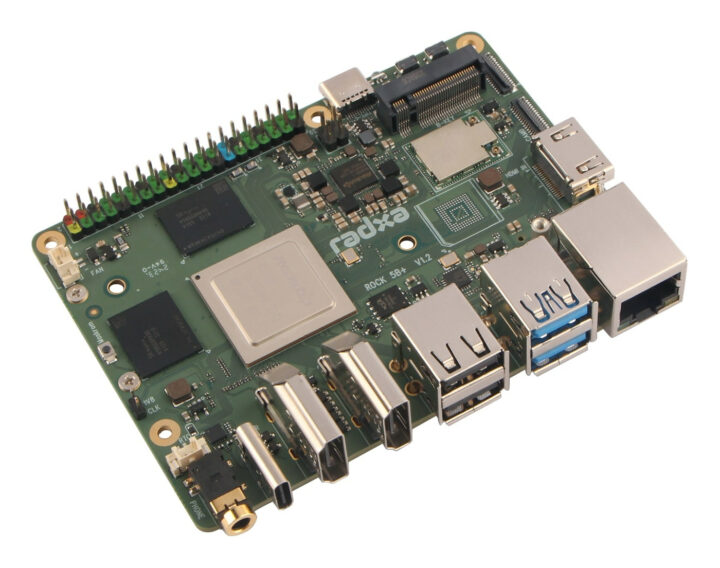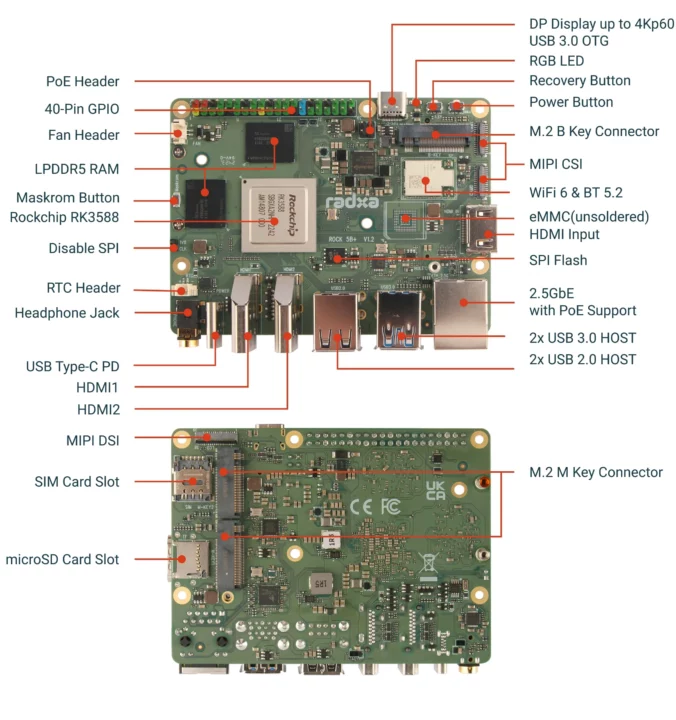The Radxa ROCK 5B+ (“ROCK 5B Plus”) is an upgrade to the Rockchip RK3588-powered ROCK 5B Pico-ITX SBC with the same form factor but various changes including a switch from LPDDR4x to LPDDR5, optional built-in eMMC flash, and an onboard WiFi 6 and Bluetooth 5.2 module instead of one connected through an M.2 Key-E connector.
Other changes include replacing the M.2 Key-M PCIe Gen 3 x4 socket with two M.2 Key-M PCIe Gen3 x2 sockets, adding a SIM card slot and M.2 Key-B socket for 4G LTE or 5G cellular connectivity, adding an extra USB-C port for power only (was multiplexed with USB-C Display Port connected in ROCK 5B), and the HDMI input relies on a full-size HDMI port instead of a micro HDMI port. Other small changes can be found in the specifications below with differences highlighted in bold and strikethrough.
Radxa ROCK 5B+ specifications:
- SoC – Rockchip RK3588
- CPU – Octa-core processor with four Cortex-A76 cores @ 2.4 GHz, four Cortex-A55 cores @ 1.8 GHz
- GPU – Arm Mali G610MC4 GPU
- VPU
- 8Kp60 10-bit H.265 / VP9 / AVS2 decoder, 8Kp30 H.264 decoder
- 8Kp30 H.265 / H.264 encoder
- AI accelerator – 6 TOPS NPU
- System Memory – 4GB, 8GB, 16GB. 24GB, or 32GB LPDDR5
LPDDR4x - Storage
- 2x M.2 Key-M 2280 sockets for NVMe SSD (PCIe 3.0 x2)
- MicroSD card slot
- eMMC flash
socket(unpopulated on currently sold ROCK 5B+ variants)
- SPI flash
- Video Output
- 2x HDMI 2.1 up to 8Kp60
- 1x USB-C via DisplayPort alt. mode up to 8Kp30
- MIPI DSI connector up to 1080p60
- Four independent displays supported
- Video Input
- 1x
microHDMI input up to 4Kp60 - 2x MIPI CSI connectors (updated to 2x 4-lane or 4x 2-lane MIPI CSI for connecting up to 4x cameras)
- 1x
- Networking
- 2.5 Gbps Ethernet RJ45 port with PoE support
- Built-in WiFi 6 and Bluetooth 5.2 module (RTL8852BE) with two antenna connectors
Support for WiFi 6E and Bluetooth 5.2 M.2 module- Support for 4G LTE and 5G module via M.2 Key-B socket and SIM card slot
- USB
- 2x USB 3.1 Gen 1 Type-A ports
- 1x USB 3.1 Gen 1 Type-C port with DisplayPort Alt. mode (USB PD not supported)
- 2x USB 2.0 ports
- Expansion
- 40-pin color-coded GPIO header
- 2x M.2 PCIe Key-M socket for SSD or AI accelerators
- 1x M.2 Key-B socket and SIM card slot for cellular modules
- Misc
- Power, MaskROM, and Recovery buttons
- RGB LED
- RTC battery header
- Fan header
- Disable SPI jumper
- Power Supply
- USB-C PD connector (power only)
- Optional PoE support
- Dimensions – 100 x 72mm (Pico-ITX form factor)
The layout has changed a bit but not dramatically, so some ROCK 5B enclosures might still be compatible possibly with some small modifications (e.g. for the HDMI input port). The Radxa ROCK 5B used to have four holes for the heatsink, but the number has been reduced to two on the ROCK 5B+ allowing extra space for the new features. The ROCK 5B+ is an upgrade in most aspects, except for the PCIe Gen 3 x4 speed previously available for the NVMe SSD which is now cut in half. Most people seem happy getting an SSD with a PCIe Gen2 or Gen3 x1 on Raspberry Pi 5, so Radxa may have figured out that having two M.2 Key-M sockets would benefit users for SSDs and/or AI accelerators even with the lower speed.
LPDDR5 offers higher bandwidth than LPDDR4x, but in practice, LPDDR5 latency is higher than LPDDR4/4x (specification/protocol issue), and the LPDDR5 clock is also set lower in Rockchip’s rkbin for improved stability, so higher performance is not guaranteed depending on the workload. At least that’s the case in ROCK 5 ITX mini-ITX motherboard, and some users also reported LPDDR5 frequency dropping sharply under load due to an aggressive DMC (Dynamic Memory Controller) configuration that works a bit like DVFS for the CPU.

The Radxa ROCK 5B and Radxa ROCK 5B+ share the same wiki, but each board has its own Debian-based Radxa OS image with features such as auto-login, backup OS, headless mode, online updates, Rsetup system configuration tool, and more. Other supported operating systems include Android 12, ChromiumOS-based FydeOS with Android app compatibility, Windows On R, and Yocto-built custom-embedded Linux images.

Radxa sells the ROCK 5B+ single board computer on AliExpress for $119.40 (16GB RAM) or $159.16 (24GB RAM). The 4GB RAM variant is supposed to start at $70, and the 8GB model at $90, but neither model is currently unavailable on AliExpress, Arace Tech, and AllNetChina websites. Models with eMMC flash are planned for later. Additional information may be found on the product page.

Jean-Luc started CNX Software in 2010 as a part-time endeavor, before quitting his job as a software engineering manager, and starting to write daily news, and reviews full time later in 2011.
Support CNX Software! Donate via cryptocurrencies, become a Patron on Patreon, or purchase goods on Amazon or Aliexpress






